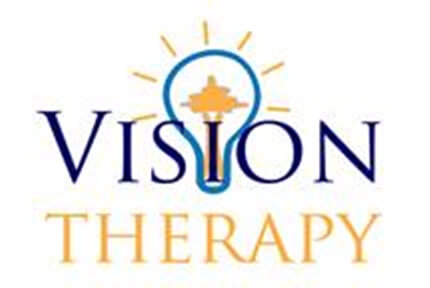
Above: Carter Hutton, Canadian professional ice hockey goaltender, undergoing convergence testing
Written By: Cassandra Biro, 3rd year Optometry Student & Vision Therapist for Dr. Debbie Luk
What is Convergence Insufficiency?
Under normal circumstances, the eyes must turn inwards to view objects at near. Convergence insufficiency results when an individual has an outward natural or resting eye posture at near which means that they must exert more effort to bring the eyes in while reading. This can make it appear as though words are moving while reading as well as lead to blurred/double vision, impaired concentration, eyestrain, drowsiness, and headaches. It is important to note that individuals with CI can and often have 20/20 vision. Clarity does not guarantee comfort when it comes to vision.
What Causes Convergence Insufficiency?
The exact cause of primary convergence insufficiency is unknown. Convergence insufficiency can arise following infection, traumatic brain injury, certain medications, neurodegenerative diseases (e.g. Parkinson’s), myasthenia gravis, or Graves ophthalmopathy. Diagnosis of primary convergence insufficiency is most common in children and young adults when they begin to experience symptoms from prolonged periods of near work.
How is Convergence Insufficiency Treated?
The main treatment for convergence insufficiency is vision therapy. Vision therapy uses various exercises to train the connection between the eyes and the brain as more than 50% of the brain is dedicated to visual function. For individuals with convergence insufficiency, therapy focuses on training the eyes to converge and eventually in the end stages to switch between convergence and divergence. Results from a study by the Convergence Insufficiency Treatment Trial Group suggest that office-based vision therapy is the most effective method for improving measures of convergence as well as patient symptoms. This is compared to home-based computer therapy and pencil push-ups (following a pencil as it is moved towards the nose). Other options such as prism lenses are only used when an individual is either unable to do vision therapy or is unsuccessful at it. There is not enough evidence to suggest that prism lenses alone are very successful at treating convergence insufficiency in children. Surgery is seldom considered due to the effectiveness of vision therapy. Further, pencil push-up exercises has been proven as ineffective.
How Long Does it Take to Treat Convergence Insufficiency? Can Convergence Insufficiency Come Back?
In general, 12-24 in-office vision therapy sessions are recommended to treat convergence insufficiency. This will vary based on compliance, the degree of convergence insufficiency (and other binocular disorders if present), age, and if there are any coexisting developmental disorders. With respect to regression following vision therapy, the Convergence Insufficiency Treatment Trial Group has found that 87.5% of children aged 9-13 were still considered either improved or successful one year after receiving treatment. Regression after vision therapy can occur after severe infection and/or traumatic brain injury.
What about adults with Convergence insufficiency?
The Convergence Insufficiency Treatment Trial Group found that for adults aged 19-30, 50% receiving office-based vision therapy for CI were either “improved” or “cured” after 12 weeks based on symptoms and clinical measures. It is possible that with more sessions there would have been a larger number of adults with CI benefitting from vision therapy. Also, investigators noted that the adults in this study improved the same amount clinically as children in another study suggesting that adults rate their symptomology differently than children.
References:
Arnoldi, K., & Reynolds, J.D. (2007). A Review of Convergence Insufficiency: What Are We Really Accomplishing with Exercises? American Orthoptic Journal, 57, pp. 123-130. Retrieved from http://aoj.uwpress.org/content/57/1/123.full.pdf
Cacho-Martinez, P. Garcia-Munoz, & A. Ruiz-Cantero, M.T. Do we really know the prevalence of accomodative and nonstrabismic binocular dysfunctions? Journal of Optometry, 3(4), pp. 185-197. Retreived from http://www.ncbi.nlm.nih.gov/pmc/articles/PMC3974377/pdf/main.pdf
Convergence Insufficiency Treatment Trial Investigator Group. (2009). A Randomized Clinical Trial of Treatments for Symptomatic Convergence Insufficiency in Children. Arch Ophthalmol, 126 (10), pp. 1336-1349. Retrieved from http://www.ncbi.nlm.nih.gov/pmc/articles/PMC2779032/pdf/nihms-148199.pdf
Convergence Insufficiency Treatment Trial Study Group. (2009). Long-Term Effectiveness of Treatments for Symptomatic Convergence Insufficiency in Children. Optom Vis Sci, 86 (9), pp. 1096-1103. Retrieved from http://www.ncbi.nlm.nih.gov/pmc/articles/PMC2780441/pdf/nihms153856.pdf
Cooper, J., & Jamal, N. (2012) Convergence Insufficiency—a major review. American Optometric Association. Retrieved from http://www.coopereyecare.com/studies/CI%20Major%20Review%20copy.pdf
Scheiman, M. & Wick, B. (2014). Clinical Management of Binocular Vision. Philadelphia: Lippincott Williams & Wilkins.
Scheiman et al. (2005). A Randomized Clinical Trial of Vision Therapy/Orthoptics versus Pencil Pushups for the Treatment of Convergence Insufficiency in Young Adults. Optometry and Vision Science, 82 (7), pp. E583-595. Retrieved from http://www.convergenceinsufficiency.net/uploads/citt_adult_pilot_study_manuscript_ovs_82_583-593.pdf

